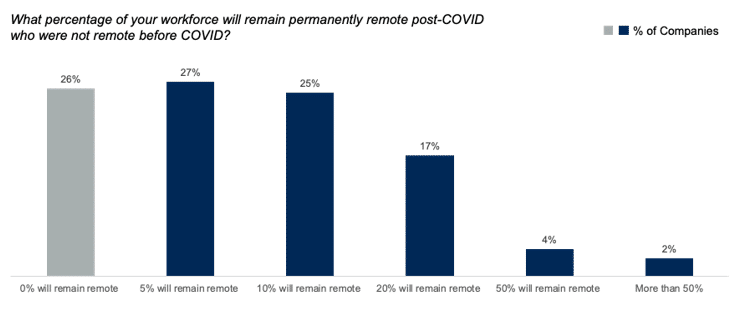As more companies are extending their remote work policies, we thought it might be a good time to revisit the concept of work from home (WFH) and see where it stands today.
While the growing popularity of flexible, off-site work arrangements is a positive thing (even if it’s by necessity), the concept of a fully remote workplace is still intimidating to many. If you’re new to remote work or just want to learn a thing or two about the WFH movement, this article is for you.
Since our team at Taskade is 100% distributed too, we want to share a handful of tips and observations on the emerging WFH reality. In the article, we dig into:
- 🥉 Essential tips for new remote employees
- 📈 The ups and downs of work from home
- 🌍 Possible outcomes of the global WFH experiment
- 👉 And more…
If you haven’t already, be sure to read our article “Work From Home: Where Is it Heading?” to get the full context for this story.
👩💻 3 Pro WFH Tips
If there’s one thing the so-called global WFH experiment has made clear, it’s this: We still have a lot to learn about remote work.
- What are the best tools for frictionless collaboration?
- How much autonomy and flexibility is *too* much?
- Are distributed teams *really* as effective than their co-located counterparts?
These are only some of the questions employees and business owners are facing today.
But don’t worry. We’re here to help. 🤝
If you’re new to the Taskade blog, we’ve already covered a lot of ground on remote work and best work-from-home practices, so be sure to go through this list when you’re done here:
- Minimalism in a Digital Remote World 🧘♂️
- Overcome Poor Communication in a Distributed Team 📣
- Synchronous vs. Asynchronous Communication 🤔
- Remote Workplace Camaraderie 🤜 ⚡️ 🤛
This time, we’ve compiled a list of 3 pro WFH tips for new remote employees. They’ll help you wrap your head around the concept of and build up a solid workflow to use in the future.
Ready?
1. Become a (Master) Communicator
There are two essential components to remote work: communication and collaboration. Whether you’re a maverick freelancer or a member of a distributed team, you’ll have to interact with your clients and colleagues. There’s no way around that.
And since it’s so important, why not become good at it?
When it comes to *effective* communication, the prescription is simple: Be brief, precise and (sometimes) overcommunicate. When you work with overseas clients or a team that’s spread across continents, the window for communication is small and sometimes limited to an hour of overlap time between time zones.
Regardless of whether you email, chat, or conference call, you should learn how to create minimum viable messages:
- 🤔 Measure twice, cut one. Instead of sending three fragmented, unintelligible messages, take your time to get that email reply right the first time
- 🥱 Respect your colleagues’ time Don’t run longwinded. Keep your sentences short and to the point. Don’t wander off the topic unless it’s by the virtual watercooler
- 🧐 Stick to a communication etiquette. When you join a virtual meeting, follow the rules everybody else does. Don’t be late and try to look presentable
So, why overcommunicate?
Remember that when you work from home, the number of interactions with your colleagues is low. That means no fist-bumps—save for virtual ones—, no socializing over Sumatran beans or swinging by your buddy’s desk for whatever reason. Without regular communication, there’s no team camaraderie, and without team camaraderie, there’s no team.
Finally, learn how to unplug. This isn’t a tip you come across very often but if you want to make friends with work from home, be sure to set clear boundaries for communication. Don’t follow the cult of the green dot 🟢 by always staying connected and give yourself permission to go offline. You should know when to call it day.
2. Find Your Work Sanctum
Kids at home? No separate room for a home office? Welcome to the less-than-ideal reality many beginner remote employees face. If you have a dedicated office space in your home, consider yourself lucky. Make the place sacred during work hours. Ban pets and kids from its premises and make sure to cut down on any distractions in your way.
If you don’t have the luxury of a proper home office, consider other options, like working from your parent’s basement (not kidding) or signing up for co-working spaces.
Although shared office venues faced some problems before the pandemic, they may return to good graces as more companies let employees work remotely. While the pandemic is not quite over, many coworking offices are already reopening under strict health guidelines.
3. *Make* Time for Work (And Play)
There’s a quote by Seneca that perfectly captures the importance of time management: “It is not that we have a short time to live, but that we waste a lot of it.”
*Making* time for meaningful work can be difficult in a regular office. But when you work from home, a lack of direct supervision and having *too* flexible schedule may quickly lead to burnout.
Why show up for virtual meetings when you have a thousand excuses—like poor internet connection—not to do so? Why work now when you have an entire day ahead of you? You can always cram through the night or catch up over the weekend, right?
Don’t fall for that.
Conversely, trying to stay productive 24/7 and never really unplugging isn’t optimal too. Even when you finally call it day, you may feel the temptation to read one last email or add a final round of edits to the project you’ve been working on. Keep that up and the line between work and personal life will become more blurry and you’ll find yourself crossing it time after time.
Instead, try to stick to a similar schedule you used to have in your office job. While this may sound counter-intuitive (where’s the flexibility in that), but a steady, predictable workflow will help you settle into the new reality more easily. Decide when’s the time to work and when’s the time to play and make your schedule sacred.
Once you’re comfortable with your daily routine, try to experiment a bit and see what you can improve. If you didn’t know that already, experimentation is the key ingredient of innovation. Start small, get up before sunrise, work fewer (or more) hours or go to bed a tad earlier.
🤔 The Ups and Downs of Work From Home
For some, the greatest work-from-home experiment is turning out great. Many remote employees have finally found the flexibility, autonomy and satisfaction they couldn’t get in the traditional 9-5 life. But others, even those who had always dreamed of working from home, took a direct hit by the harsh reality of constant distractions, screaming kids and self-imposed isolation.
So, is work from home really that cool?
1. Autonomy Can Be a Double-Edged Sword
Balancing flexibility and organizational structure in distributed teams is a tricky business. On the one hand, as a remote employee, you have the autonomy to tackle work how, where and when you see fit. On the other, a lack of direct supervision makes it problematic for managers to apply any KPIs that would even remotely (pun not intended) reflect the productivity of distributed teams.
But there are other problems.
Some people are simply not cut out for remote work. Sometimes it’s because they lack an internal timekeeper to keep them *actually* working and pull back on track when they start slipping. Others may feel more productive under the watchful gaze of a manager or team leader. And there’s nothing wrong with that.
Don’t get us wrong. We believe remote work is great, it’s just it may not be the most optimal solution to force everybody on that bandwagon. With all the benefits of remote work, there should still be a place for choice so employees can decide how they want to work.
And this is the philosophy that drove Twitter’s last month announcement:
“We were uniquely positioned to respond quickly and allow folks to work from home given our emphasis on decentralization and supporting a distributed workforce capable of working from anywhere. The past few months have proven we can make that work. So if our employees are in a role and situation that enables them to work from home and they want to continue to do so forever, we will make that happen. If not, our offices will be their warm and welcoming selves, with some additional precautions, when we feel it’s safe to return.”
Jennifer Christie, Chief HR Officer at Twitter
2. The Team Culture Conundrum
Have you ever felt isolated at work? Unless there are some nasty personal animosities going on, chances are your relationship with the rest of your team is OK. But is it possible to build a similar rapport with people that are a thousand miles away?
Building a healthy team culture and fostering camaraderie in co-located teams isn’t a trifle. It takes time and solid managerial skills to get everything running smoothly.
- 🤝 Can team camaraderie thrive across time zones?
- 👥 Do remote employees feel an integral part of their companies?
- 🎯 Do they care about company values and mission?
- 🏗 How do you build team culture in a distributed organization?
If you want to feel an integral part of your (new) remote team, you should focus on two things: Initiative and (over)Communication. Take the extra step and reach out to your new colleagues. Show initiative and get involved in building team culture from day one.
“Remote work is this incredible invitation to really get good at building inclusive cultures where there’s a wide variety of types of people, and to build a culture where everyone feels included and everyone is experiencing ongoing growth and development on a regular basis. That’s the challenge, and it’s not an easy one. But the business isn’t easy.”
Shane Metcalf, 15Five
🧭 Whither Goest Thou, Work from Home?
Some time ago, we shared our predictions on how the modern workplace could look like in a post-COVID19 world. Today, as the situation stabilizes in some parts of the world, we now that many companies are seriously considering sticking to work from home for a spell.
“Softened” by promising results of the WFH experiment, companies like Twitter, Square Facebook and Shopify are all extending their remote work policies, some indefinitely. But it’s not just the big fish that jump on the WFH bandwagon.
In a study by Gartner, 74% of businesses declared that they would continue to develop remote work strategies and make remote employees an important part of the business.

Post-COVID predictions for remote work via Gartner.
But the possible changes to the workplace as we know it are *not* only about who can work from home and how long they’ll do so. Companies who were forced to roll out impromptu remote work processes will likely focus on refining them beyond COVID-19.
Here’s what we can expect:
1. Remote Collaboration Will Continue to Grow
We’re proud to be part of the work-from-home movement and continuously enable our customers to deliver in this difficult time. And it looks like remote collaboration will only grow stronger in the coming months. As Kate Lister, President of Global Workplace Analytics, commented
“(..) 25-30% of the workforce will be working-from-home multiple days a week by the end of 2021.”
While this figure is merely an estimate, we’re pretty sure both employees and business owners will keep looking for ways to improve the quality of remote collaboration. And as that happens, we’ll be there for you.
2. International Talent Will Be Hot
Even before COVID-19, international talent pools were gold mines for progressive employers who wanted to build 100% distributed dream teams. Once the current situation is put back under control, reopening businesses will be looking to replenish the talent they had to let go when the crisis started. And many will turn overseas to look for a skilled, flexible and fully remote workforce.
3. Physical Office Spaces Will Be… Different
While the 6-feet rule won’t stay with us forever, some predict the current social-distancing recommendations may transform traditional office as we know it. Vox reports that the design and architecture communities have already suggested a number of possible changes to make physical office spaces safer and crisis-proofed for the future. The only problem is many employees who’ve tasted WFH, won’t be so inclined to go back to their cubicles anytime soon.
🐑 Work From Home with Taskade
Can’t wait to use the tips you learned in this article? Why not start implementing them right away with Taskade? Taskade is a communication and collaboration platform that helps remote employees and distributed teams get work done with class.
You can sign up for a free account here 👈!
💡 Before you go, feel free to grab this handy checklist that’ll help you get into gear with work from home and check (pun not intended) if you’re ready to rock:
🤖 Custom AI Agents: Tired of doing everything yourself? Create teams of autonomous AI agents to automate your projects and tasks.
🪄 AI Generator: Tasks, projects, mind maps, flowcharts — generate high-level project structures in seconds, powered by GPT-4 Turbo.
✏️ AI Assistant: Leverage the AI Assistant for real-time writing support. Brainstorm, outline, generate, and edit using handy /AI commands.
🗂️ AI Prompt Templates Library: Explore a range of prompts, covering everything from time management to project organization.
And much more…



 14 Best AI Tools for Planning and Running Meetings
14 Best AI Tools for Planning and Running Meetings  Creating Customer Service SOPs: A Guide for Streamlining Your Support
Creating Customer Service SOPs: A Guide for Streamlining Your Support  15 Top AI Content Marketing Tools for Remote Teams
15 Top AI Content Marketing Tools for Remote Teams  9 Top AI Brainstorming Tools for Virtual Teams in 2024
9 Top AI Brainstorming Tools for Virtual Teams in 2024  14 Best AI Collaboration Tools for Remote Teams (Updated 2024)
14 Best AI Collaboration Tools for Remote Teams (Updated 2024)  What Are SOPs? Building Effective SOPs With AI in 2024
What Are SOPs? Building Effective SOPs With AI in 2024